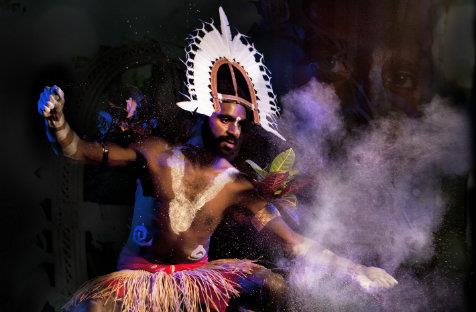Move over Bangarra Dance Theatre. There’s a new star rising, and it hails from the Torres Strait. Its name? Baiwa Dance Company. Formed in 2005, it’s a small company numbering but six dancers – three contemporary female dancers and three traditional male dancers. However, on stage, the company seems much larger. These consummate performers are supported by a large cast of supporting artists, who contribute musical accompaniments, brilliant set design, perfectly synchronised drums and lighting, and traditional costumes that are quite breathtaking. Last Friday night, a full house in Cairns gave them a well-deserved standing ovation. Baiwa’s director is Rita Pryce, who attributes to her late uncle, Ephraim Bani, the idea of putting on stage for all to enjoy the major elements of traditional Island culture with its continuing connection to land, sea and sky.
Some years ago, I spent a week in the Torres Strait, most of it on Thursday Island. It was all too short a stay, just enough to scratch the surface really, but during that time, I met accomplished mariners, brilliant story-tellers, a Japanese pearl cultivator, and some of the friendliest strangers I have ever encountered. Its turquoise waters and green islands conceal a turbulent history of fierce tribal warfare in past centuries, and the chequered reputation of the pearling luggers in the early 20th, whose Islander and Japanese divers often perished in their quest for the elusive pearl and trochus. A sense of the exotic is etched in my memory; and the most enduring memory of all is of the incessant winds blowing with gale force day and night. They are a constant in the Straits. The seasons are measured by them. Warupaw Uu / Echo of Drums takes the rituals that accompany this changing of the seasons as its focus and raison d’être.
The performance opens with a procession to the accompaniment of a song, ‘Ngapa Gamulka’. It is an arresting opening. Soon the bare stage is filled with colour and movement. A large full moon with a war shield superimposed on it shines over the company, as the elder, Adhi Dimple Bani (son of Ephraim) steps forth to deliver a welcome. Looking for all the world like Nelson Mandela, he addresses the audience. ‘The beating of the drum is like a heartbeat, echoing through time, echoing through the generations,, linking us back to our heritage, through the four directions of the wind — Naigai, Sager, Kuki, Zei ─ sharing it with others so that there will be always an understanding and respect for each other.’
What follows is a kaleidoscope of rhythm, sound, and movement pregnant with meaning. Each dance represents one of the four winds and its seasonal story. The first, Naigai, is the Star Dance, a contemporary interpretation of the constellation that starts to appear in the sky when the Naigai starts to blow. The dancers wield starry handpieces that snap open and shut in time with the drumbeat. The execution is flawless, every dancer in sync with the rest, every star appearing on cue. Fascinating!
There follows a traditional boat dance, in which the men carry models of three-masted pearling luggers making their way through choppy seas. Again the synchronisation is flawless. The accompanying music tells part of the story. The moonshine over the stage tells the rest as it changes to a symbolic depiction of the scene by the late Billy Missi, in the distinctive Island style of Denis Nona and his contemporaries. I could go on and on ─ with accounts of the men’s hunting dance, or the women’s farewell to their warrior husbands going off to fight, or the sik and paddle dance that concludes the show.
Here the cast come together as one to depict the gathering of different island groups, young and old all together, celebrating the arrival of Sager, the south-east wind. It would be futile to describe these dances in detail, as words can only do so much. Far better to be in the audience, captivated entirely with the spectacle, the precision, the music and the drumbeats. Indeed, some in Friday’s audience were so captivated that they cried out during the performance, adding their own commentary, as it were, to the action on stage.
To single out particular performers would be invidious. The dancers are all superb, and their teamwork is exceptional. Similarly, it is perhaps invidious also to compliment just some of the supporting crew, but I’ll risk it in making special mention of the lighting designer, Glenn Hughes. His backlit moonscapes added significantly to the sense of ‘being there’. The sound engineer, Nigel Pegrum, worked his usual magic, and the original music contributed by Rita Pryce and two of the dancers – George Dow and Dolly McCaughey – added yet another magical touch. The traditional headdresses by George Nona were instantly recognisable. They are a feature of the Torres Strait Island flag, and provided another point of reference for a mainland audience.
Warupaw Uu / Echo of Drums is billed as a highlight of the Cairns Indigenous Arts Fair, currently in progress. It certainly is that – in fact it’s more than that. It’s a major triumph for the Baiwa Dance Company, a stunning portrayal of Island culture for those of us who unfortunately know little enough about it. There’s so much we have yet to appreciate there.
Warupaw Uu / Echo of Drums
Presented by Baiwa Dance Company
Directed by Rita Pryce
Choreographed in collaboration with dancers of Baiwa Dance Company
Dancers: Rita Pryce, Peggy Misi, Barbara Drummond, George Dow,
Arthur Gisu, Patrick Vandenbroek, Cleopatra Pryce, Shakira Walker
Lighting Design: Glenn Hughes
Artwork: Billy Missi
Music: Dolly McGaughey, Rita Pryce and George Dow, in collaboration with the dancers of Baiwa Dance Company
Cultural Advisors: Dolly McGaughey, Chief Dimple Bani and the late Billy Missi
Sound Engineer: Nigel Pegrum
Centre of Contemporary Arts, Cairns
16 – 17 August
(Pictured: Arthur Gisu in Warupaw Uu / Echo of Drums. Image: Paul Dymond.)





